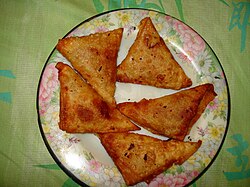Samosa
Thank you for being part of the Bharatpedia family! 0% transparency: ₹0 raised out of ₹100,000 (0 supporter) |
 | |
| Alternative names | Samsa, somsa, sambosak, sambusa, samoosa, singada, samuza |
|---|---|
| Region or state | Indian Subcontinent, Central Asia, Western Asia, Horn of Africa, North Africa, South Africa |
| Main ingredients | Maida or plain flour, potato, onion, spices, green chili, cheese, meat |
Samosa is a popular snack originally from Central Asia. It further travelled, with the help of Muslim merchants of trade routes to India.[1] It is famous in the Indian subcontinent as well as Southeast Asia, Central Asia, Southwest Asia, the Arabian Peninsula, the Mediterranean, the Horn of Africa, North Africa, as well as South Africa.
It is generally prepared in the shape of a triangle, however, the shape and sizes tend to vary from region to region.[2] It can be either baked or fried and has an outer hard crust made of plain flour. It usually has a filling of potatoes and spices.[3] It is usually eaten with a spicy sauce called chutney.
Samosa is also an appetiser in Pakistan.
It is commonly available in canteens, sweet shops and is also prepared at home.
Samosa can be vegetarian or non-vegetarian.
Origins
It is believed to have originated from the Central and West Asia. The word samosa originates from the Persian word sanbosag.[4]
| Language | Name |
|---|---|
| Marathi | Samosa |
| Urdu | Sambusak |
| Turkish | samsa böreği |
| Oriya | Shingada |
| Russian | Самса́ [samsa] |
| Bengali | Sing-ra |
| Persian | سمبوسه [Samuza] |
References
- ↑ Padgaonkar, Dileep (25 September 2011). "Anyone for a samosa?". The Times of India. Retrieved 22 June 2012.
- ↑ "Nigerian Samosas". AvartsyCooking. Retrieved 22 June 2012.
- ↑ Dalal, Tarla. Non-Fried Snacks. Sanjay & Co. p. 12. ISBN 978-81-89491-82-6. Retrieved 22 June 2012.
- ↑ Duggal, Girija (23 August 2008). "Lovely triangles". Hindustan Times. Retrieved 22 June 2012.
